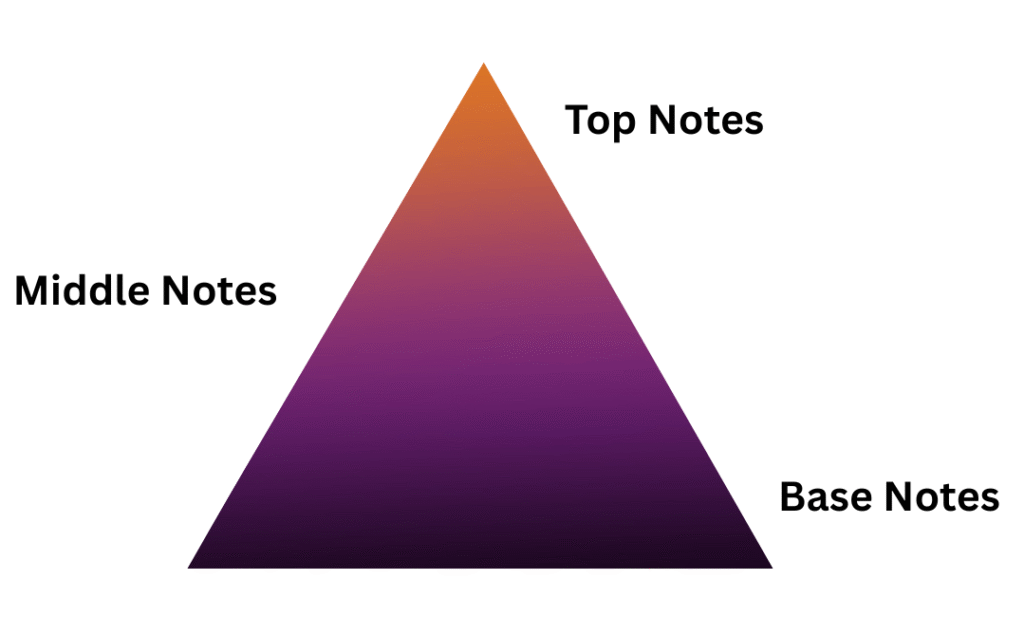The sense of smell is difficult to translate into words. Humans are highly visual creatures, so it helps to have a visual representation of perfumes to help us make sense of what we are smelling. Hence the perfume pyramid. It is, for all intents and purposes, a triangle with the ‘top notes’ (also called the head notes) at the tip, the ‘middle notes’ (also called the heart notes) below it, and the ‘base notes’ at the bottom.
The notes are usually a list of what you would perceive when you spray a perfume on. It isn’t strictly a list of the fragrant ingredients that went into the creation of the perfume. It’s easier to believe when you see outrageous notes like fish, dust, or nail polish– surely, the perfumers didn’t throw an eel into the formula. But it’s true for notes that are more common like lily-of-the-valley, peony, and heliotrope. This is because certain flowers simply don’t have a fragrance, yield very little fragrance oil, or are impossible to extract fragrance from. This is when the fragrance is created synthetically in a lab to closely resemble its fragrance or what it would smell like.
Take lily-of-the-valley. Chances are high that when you perceive the note, you’re actually smelling compounds like lilial, lyral, or hydroxycitronellal. But you can hardly list hydroxycitronellal or eugenol as perfume notes. It defeats the entire purpose of simplifying scent for our understanding.
The same way, the perfume pyramid isn’t a strict layering of notes one on top of the other but a rough guide to what we may smell in a perfume.

The layers of the pyramid
Top Notes
The top notes are typically what we perceive first when we spray a perfume on. They are the lighter, more volatile molecules and so evaporate quickly. When we try a perfume at a store, these notes play a crucial role in our purchase decision. First impressions and all. They are comparatively fresher. Think citruses, oceanic, light florals, and certain aromatics. They are the first set of notes to evaporate off the skin and are expected to last anywhere from 1 to 2 hours. This isn’t a strict rule of course, and sometimes the top notes stick around till the end.
Middle Notes
While the top notes are composed of lighter notes, the middle notes tend to be richer. So, aromatics, heavier florals like jasmine and tuberose, spices like cardamom and nutmeg, fruits like mango and pineapple, and so on. They are usually detectable as the top notes begin to fade away, but can be present along with the top notes. So when you’re buying a perfume, you’ll get a better perception of how it’ll smell on you if you let it sit for a few hours. Depending on the type– the family, the concentration, the middle notes last quite a few hours.
Base Notes
These notes are also described as what we perceive in the dry-down. The molecules here are the heaviest and hence the last to evaporate from your skin. Still smell your perfume on your shirt days later? It’s most probably the base notes. They are expected to appear at the disappearance of the heart notes. They’re the more sensual, intense and rich notes in the composition. Think woody (sandalwood, cinnamon, ebony), musky, and ambery notes. A lot of the time, the base notes are used to extend the longevity of a fragrance.
They can peek in through the top notes, perceived at once, or are shyer and need some patience on your part to reveal themselves.
The Nuances
What I described above is only a general guideline. But the real-life perception of a perfume cannot be so rigidly demarcated into three layers or stages. Depending on the formulation, there are top notes that last throughout the life of the fragrance on your person. Yes, even the freshies and their volatile citruses can be perceived hours later.
Not everything you smell is listed in the pyramid. Go to any perfume forum and you’re certain to find arguments about which notes are actually present in a perfume. It’s hard to say who’s right and who’s wrong. It’s simply what people perceive. Eugenol, for example, can smell like carnation in some forms and like rose in others. Someone might perceive it as clove or dill and be shocked when it isn’t listed in the pyramid. This is because eugenol is naturally found in all these materials in varying percentages.
You may not be able to smell every note listed on the pyramid. This can just be your untrained nose. We don’t really come across most perfume notes in our everyday lives and so they can be hard to identify in perfumes.
It’s possible that you’ve become noseblind to certain notes or entire perfumes. If you’ve been wearing a perfume for years or simply sprayed too much of it, your brain simply becomes habituated to it or overwhelmed and hence doesn’t perceive it the same.
Our sense of smell, just like other senses, informs us about the world. The body tends to prioritize information about newer scents in your environment to notify you of potential dangers. Someone who has just entered a room is more likely to spot a foul odor than someone who has been in the room for quite some time. The new stimulus is far more important to your body- letting you know about a gas leak takes precedence over the rose perfume that has been on your skin for a few hours.
We are all wired differently. For a small, but not insignificant portion of the population, cilantro tastes like soap. This is because they have the olfactory receptor genes that are more inclined to pick up the aldehydic soapy facets of cilantro much better than the rest of the population. White musks, cetalox, Iso E Super are a few notes that a lot of people can’t smell.
Your body chemistry is also part of this variation in wiring. A set of fragrance samples were passed around the office when I smelled something very sweet on a colleague’s wrist. When I tried it on my own skin, however, I got absolutely nothing. Even something like your monthly cycle can change how you perceive a perfume. Your skin type- dry, normal, or oily can impact this. But you can change this by using an unscented lotion or a scented lotion of the same fragrance.
Your environment when you use a perfume also impacts how you smell it. A humid environment can intensify the smell whereas a dry environment can cause quicker evaporation. If you tried a perfume on at an air conditioned mall, it might smell different when you’re out and about under the Dubai sun. This is why we rotate our fragrances out depending on the season. Warm, deep fragrances feel more intense and overwhelming in the summer but pleasant in colder months. Freshies can be fully undetectable in colder months.
The structure of a perfume formulation doesn’t always have to be a pyramid. There are quite a lot of perfumes that come off in a more linear fashion. You can use the pyramid as a general guide, but the best way to understand a perfume is to just smell it.






